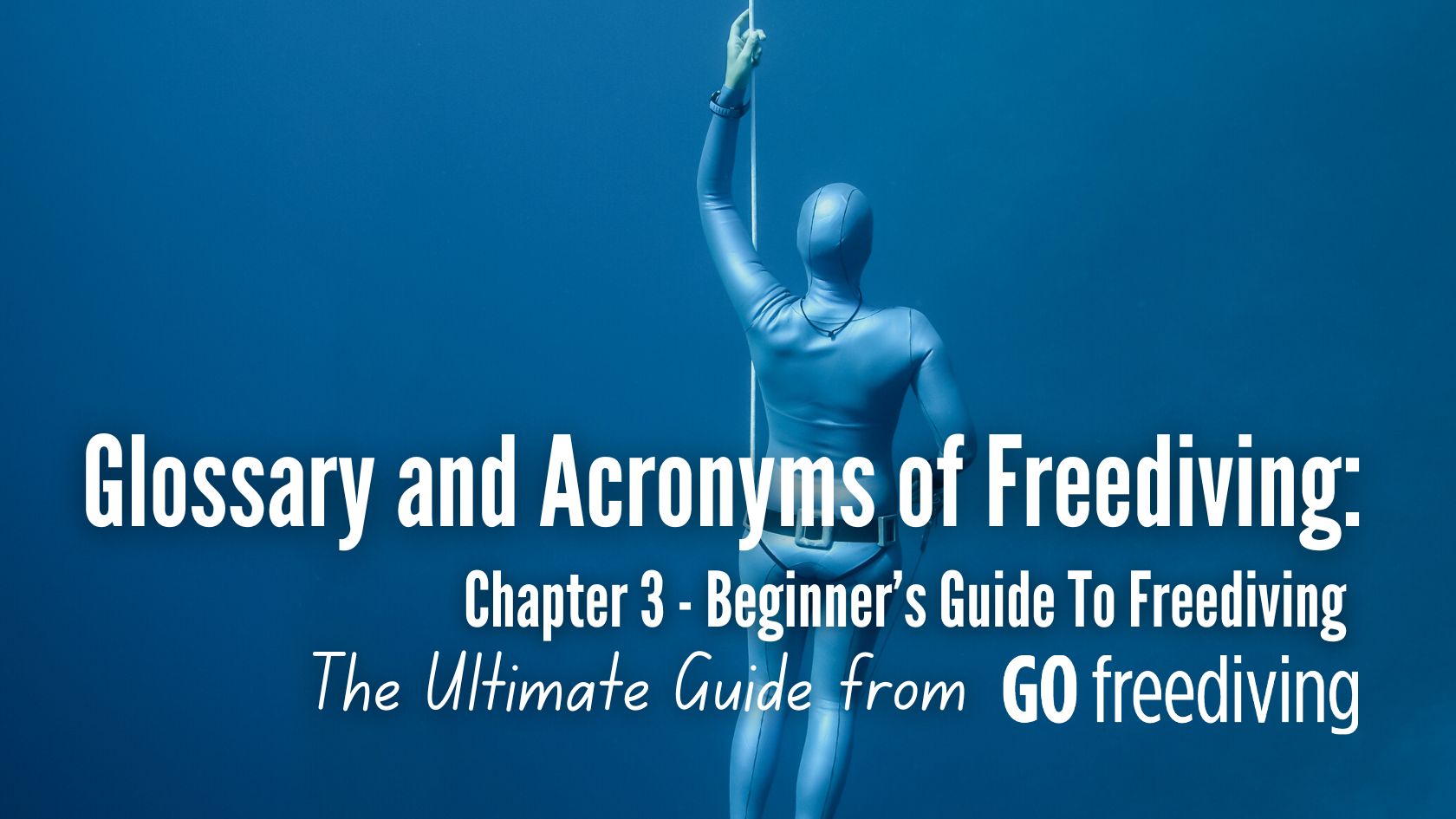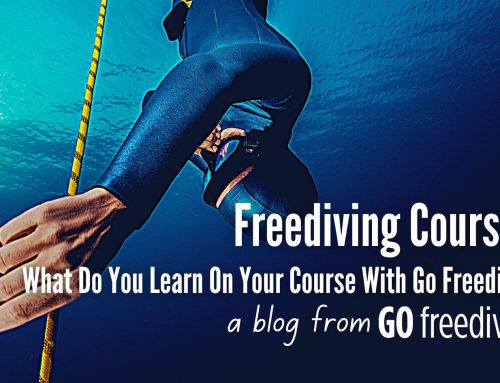Welcome to part three of The Beginner’s Guide to Freediving, the best place to start your freediving journey. In this chapter, we take a look at the Glossary of Freediving – including freediving disciplines, lung measurements and terms used. Freediving, much like any sport, has it’s own lingo or insider language. Here we’ve collected some of the most common terms you’re likely to read or hear, and collated them into this handy Glossary of Freediving.
Glossary of Freediving – Freediving disciplines
- Static (STA)– Holding one’s breath as long as possible, whilst lying still and face down on the surface of the water.
- Dynamic (DYN)– Swimming distance horizontally underwater, usually in a swimming pool, whilst wearing bi-fins or a monofin.
- Dynamic No Fins (DNF)– Swimming distance horizontally underwater, usually in a swimming pool, without fins.
- Constant Weight (CWT)– Diving to depth and back, with bi-fins or a monofin, wearing the same amount of weight for the descent and ascent.
- Constant No-Fins (CNF)– Diving to depth and back, without fins, wearing the same amount of weight for the descent and ascent.
- Free Immersion (FIM)– Diving to depth and back without fins, but by pulling down and back up a dive line, wearing the same amount of weight for the descent and ascent.
- Variable Weight (VWT) – Diving to depth using weight, then leaving the weight at the bottom and ascending by finning and/or pulling on a dive line using the arms.
- No-Limits (NLT) – Diving to depth using weight, and then using a lift-bag or other buoyancy device to return to the surface.
Glossary of Freediving – Lung measurements
- Total Lung Capacity (TLC) – The total amount of air in our lungs after a maximum inhale.
- Vital Capacity (VC) – The total amount of air we are able to inhale and exhale.
- Residual Volume (RV) – The amount of air left in our lungs after a full exhale.
- Tidal Volume (TV) – The amount of air breathed in and out when relaxed and at rest.
- Inspiratory Reserve Volume (IRV) – The amount of air able to be inhaled after a passive inhalation (from the top of tidal volume).
- Expiratory Reserve Volume (ERV) – The amount of air able to be exhaled after a passive exhalation (from the bottom of tidal volume to the top of residual volume).
- Functional Residual Capacity (FRC) – The amount of air left in the lungs after a passive exhale (ERV + RV = FRC).
- Packing – A discredited technique whereby a freediver forces more air into their lungs than the lungs could normally take.
- Overpacking – When a freediver packs too much air into their lungs, causing a buildup of pressure that in turn causes the blood vessels supplying the brain to close and the freediver to black out.
- Reversed packing – A technique whereby the freediver removes as much air from their lungs as possible, creating negative pressure, to increase diaphragm flexibility and simulate the reduction in lung volume caused by deep dives.
Glossary of Freediving – Oxygen and carbon dioxide related terms
- Hypoxia – A lower than normal level of oxygen in the blood.
- Hypoxic Fit – A loss of motor control caused by low levels of oxygen.
- Hypercapnia – A higher than normal level of carbon dioxide in the blood.
- Hypocapnia– A lower than normal level of carbon dioxide in the blood.
- Blackout– A loss of consciousness as a result of excessively low oxygen levels in the blood.
- Cyanosis– Blueness or whiteness in areas of the body, most commonly the lips, showing low levels of oxygen in the blood.
- Shallow Water Blackout (SWB) – A loss of consciousness during the last part of an ascent from a freedive (usually within the last ten metres). Caused by levels of oxygen in the blood dipping too low as the volume of air inside the lungs increases and oxygen travels from the blood back into the lungs.
- Deep Water Blackout – An incredibly rare situation where a freediver suffers a blackout at depth.
- Samba – A term freedivers used in the past to describe a Hypoxic Fit, as it sometimes resembles the dance of that name.
Glossary of Freediving – Competition Terms
- Official Top – The official start time at which a freediver needs to begin a competition performance.
- White / Yellow / Red Card – A card shown by judges following a competition performance, signalling their assessment of the dive. White means a good performance without any penalties, yellow is a good performance with penalties, and red is for disqualifications.
- Surface Protocol – A series of actions freedivers are required to perform following any competition dive, swim or static. The diver must remove all face equipment, give an okay signal and say “I’m okay” in English within 15 seconds of their airway breaking the surface. Failure to do so results in a disqualification.
- Announced Performance – An official announcement of a freediver’s intended performance.
- Realized Performance – A freediver’s actual official performance.
- Tag– A marker that freedivers must reach, grab and bring to the surface during depth disciplines.
Glossary of Freediving – General Terms
- Buddy – Your training partner or safety support, who looks after your safety during your dive or breath hold.
- Personal Best (PB) – The deepest depth, longest distance or longest time achieved by a diver.
- Freefall – The moment when the diver reaches sufficient negative buoyancy on a dive to sink without physical effort.
- Decompression Sickness (DCS) – Caused by nitrogen coming out of saturation in the blood too quickly.
- Squeeze – A barotrauma affecting the ears, sinuses, mask or lungs when the air spaces have not been successfully equalised at depth.
- Narked– Feeling the effects of nitrogen narcosis.
- Oxygen assisted static – A static breath hold in which the breathing preparation is done entirely on pure oxygen. Due to pure oxygen being toxic at depth, this is only ever used at the surface.
- Freediving under ice – A recreational form of freediving whereby divers dive down lines under ice or along a line linking ice holes.
- Skandalopetra diving – A form of No-Limits freediving based on ancient Greek sponge diving techniques. The diver descends by holding a large stone (the skandalopetra) which has a hole drilled through it and a rope attached. When the diver gets to depth, they wrap their wrist around the rope and tug sharply. This gives the people on the surface the cue to pull the diver up to the surface.
Written by Emma Farrell
The Beginner’s Guide to Freediving is written by Emma Farrell. She is one of the world’s leading freediving instructors and has been teaching freediving since 2003. She is the author of the book ‘One Breath, a Reflection on Freediving’, has written courses that are taught worldwide, taught gold medal winning Olympic and Paralympic athletes, and has appeared numerous times on television teaching everyone from Hugh Fearnley-Whittingstall to Ellie Simmonds how to freedive.
Learn to freedive with the author of The Beginner’s Guide to Freediving
Go Freediving is the longest established, most experienced and friendliest freediving course provider in the UK, led by world class freediving instructor trainer Emma Farrell, and her team of personally trained instructors. No other course provider has such a good instructor to student ratio, safety record and personal touch.
Whether you’re a beginner dipping your toes into the world of freediving, a seasoned pro looking to turn professional, or simply a freediver of any level who wants the best freediving holiday in the world, we’re here for you!
Learn more about Freediving
Read the previous chapter of The Beginner’s Guide to Freediving – ‘History of Freediving’ here now
Read the next chapter of The Beginner’s Guide to Freediving – ‘Do I need to do a Freediving Course (and who offers courses)’ here now.
Keep in touch with everything Freediving
Subscribe to our mailing list for weekly newsletters with exclusive articles, news, films, offers and more!







Leave A Comment